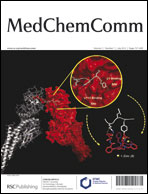A series of novel phenyl-imidazo[1,2-a]pyridines was evaluated in the context of developing improved imaging agents for β-amyloid (Aβ) in Alzheimer’s disease (AD) and as a useful probe for in vitro studies. The results from binding experiments in vitro, together with biodistribution studies, autoradiography and in vivo stability studies demonstrated that radioiodinated 2-(4′-bromophenyl)-6-iodoimidazo[1,2-a]pyridine (BrIMPY, 4b) is promising for preclinical and clinical imaging of Aβ. The no-carrier-added radioiodination of 4b was successfully performed through an iododestannylation reaction from the corresponding trimethyltin derivative. [125I]4b and [124I]4b selectively labeled Aβ-plaques in brain tissue of an APP/PS1 mouse model of AD and their pattern of uptake showed excellent correlation with Aβ plaque pathology as measured by ex vivo immunohistochemistry. The present results suggest that radioiodinated 4b possesses the properties needed as a tracer suitable for in vivo and in vitro studies, with potential for both PET and SPECT imaging of β-amyloid plaques in the living brain.
![Graphical abstract: Development of an improved radioiodinated 2-phenylimidazo[1,2-a]pyridine for non-invasive imaging of amyloid plaques](/en/Image/Get?imageInfo.ImageType=GA&imageInfo.ImageIdentifier.ManuscriptID=C2MD20115A&imageInfo.ImageIdentifier.Year=2012)
You have access to this article
 Please wait while we load your content...
Something went wrong. Try again?
Please wait while we load your content...
Something went wrong. Try again?
![Graphical abstract: Development of an improved radioiodinated 2-phenylimidazo[1,2-a]pyridine for non-invasive imaging of amyloid plaques](/en/Image/Get?imageInfo.ImageType=GA&imageInfo.ImageIdentifier.ManuscriptID=C2MD20115A&imageInfo.ImageIdentifier.Year=2012)

 Please wait while we load your content...
Please wait while we load your content...